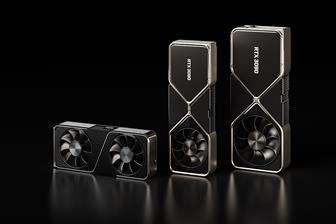
Huawei's Mate 10 smartphone is powered by the AI-specific Kirin 970 chips, built using a 10nm process atTSMC featuring an octa-core ARM Cortex CPU, a Mali-G72 12-core GPU and a neural processing unit (NPU) designed specifically for a mobile device, according to the vendor.
The NPU, combined with Huawei's HiAI mobile computing platform, enables the Kirin 970 to deliver 25x better performance and 50x greater energy efficiency for AI-related tasks, compared to four Cortex-A73 cores, Huawei claimed.
The Mate 10 comes with a 5.9-inch LCD Quad HD screen with a 2,560 by1,440 resolution, 4GB RAM and 64GB internal storage that can be expanded up to 256GB via a microSD card. It features dual 4G SIM support and dual VoLTE connections.

Samsung HKMG DDR5
Samsung Electronics has expanded its DDR5 DRAM memory portfolio with a 512GB DDR5 module...
Photo: Company

Nvidia GeForce RTX 30 series GPUs
Nvidia's GeForce RTX 30 series GPUs are powered by the company's Ampere architecture. The...
Photo: Company

Apple HomePod mini
Apple's HomePod mini is the newest addition to the HomePod family. At just 3.3 inches tall,...
Photo: Company

Apple 13-inch MacBook Pro with Magic Keyboard
Apple has updated the 13-inch MacBook Pro with the new Magic Keyboard for an improved typing...
Photo: Company

Apple iPad Pros
Apple's new iPad Pros comes with the latest A12Z Bionic chip, an ultra-wide camera, studio-quality...
Photo: Company
- South Korean president declares martial law (Dec 3) - The Financial Times
- China dials up US trade tension with tit-for-tat metals ban (Dec 3) - Bloomberg
- Silicon photonics set for takeoff (Oct 30) - EE Times
- TikTok founder becomes China's richest man (Nov 1) - BBC News
- Nvidia to take Intel's spot on Dow Jones Industrial Average (Nov 1) - Reuters
- Huawei's latest AI processors were made by TSMC (Oct 22) - Bloomberg
- Arm to scrap Qualcomm chip design license in feud escalation (Oct 23) - Bloomberg
- Embedded World brings 3,500 visitors to 1st US outing (Oct 11) - EE Times
![]() Microsoft's custom chip sets new industry benchmark while deepening AI partnerships across sectors
Microsoft's custom chip sets new industry benchmark while deepening AI partnerships across sectorsAs Microsoft transitions from a software giant to a cloud leader, with its cloud business now accounting...
![]() TASTI 2024
TASTI 2024From groundbreaking satellite advancements to international collaboration on space exploration, DIGITIMES Asia delivers comprehensive coverage of TASTI...

CSP in-house development of ASIC accelerators
Google TPUs will see a share of over 70% in the in-house developed cloud ASIC accelerator market in 2024; an all-optical network...

AI chip market outlook 2023-2028: Insights from demand and supply perspectives
The growing demand for AI computational power is accelerating advancements in hardware and chip technology, necessitating innovation...

Automotive CIS tech development, 2024
The popularization of autonomous driving is boosting demand for automotive CIS with LFM and HDR being mainstream development...





